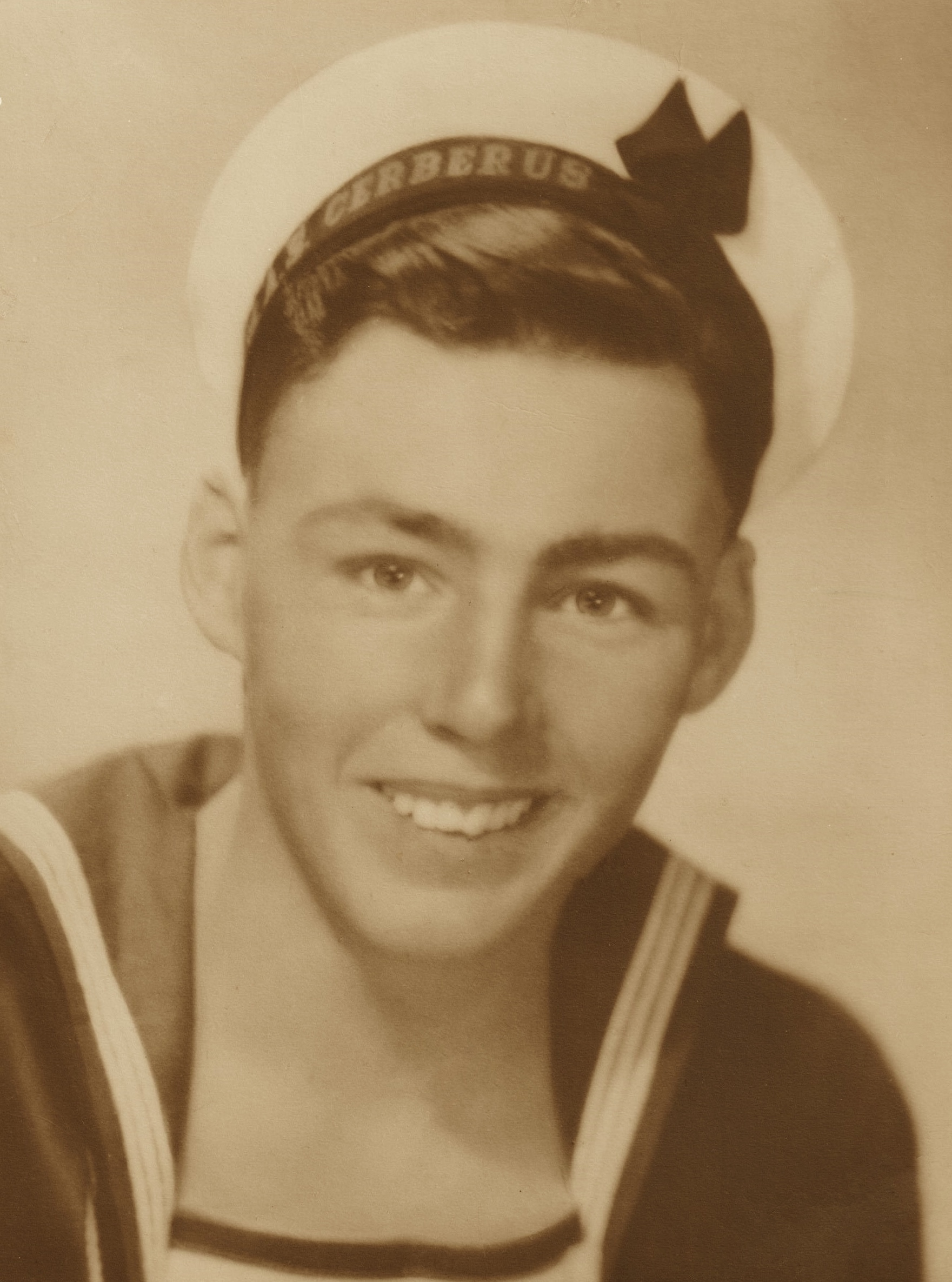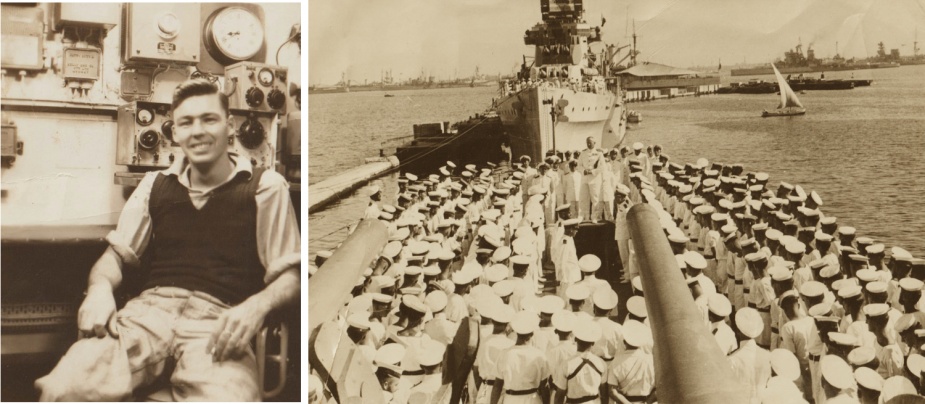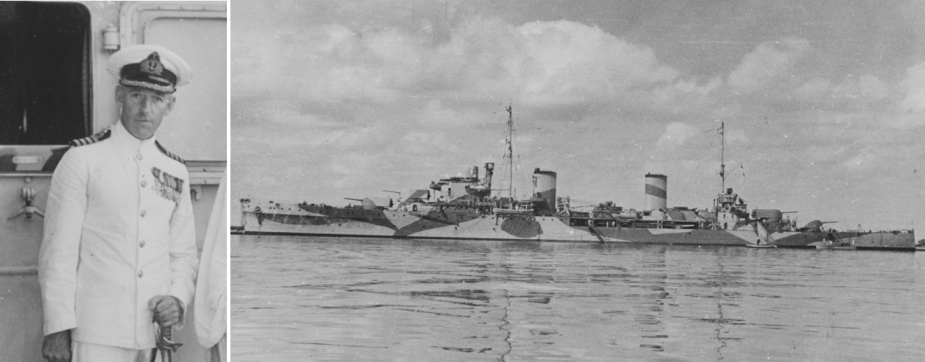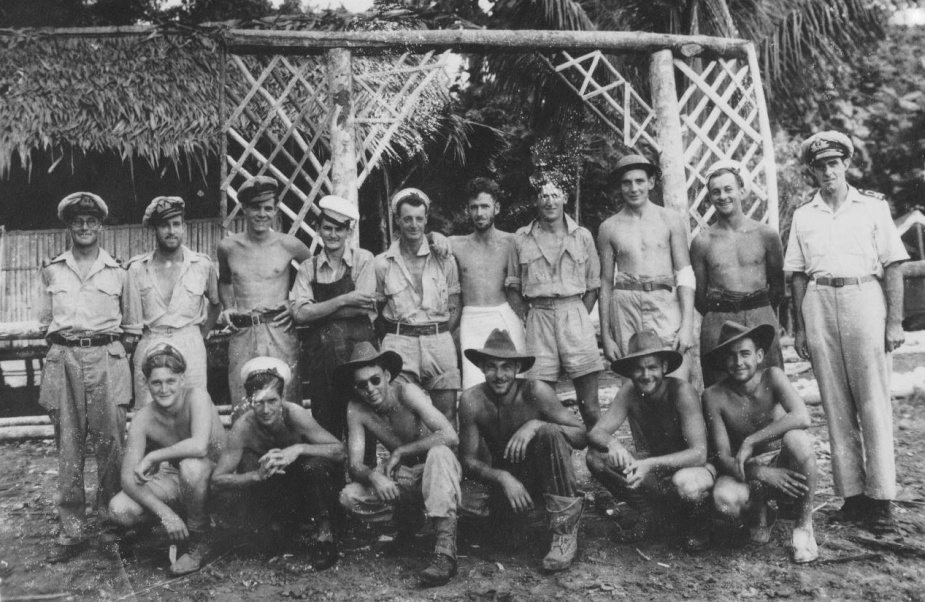Able Seaman Bill White

By CPO Bill Hayward RAN (Ret’d)
Arthur William (Bill) White was born in Winchester in the Carramar District of Western Australia on 16 June 1922, the son of Arthur and Florence White. Arthur Snr had migrated to Australia from England in 1911 and enlisted in the AIF on 14 September 1914. He was wounded in action in May 1915 and admitted to hospital in Alexandria. Arthur later became aide to General Sir Cyril Brudenall Bingham White (Lieutenant Colonel at the time) who became famous for the successful evacuation of Australian troops from Gallipoli. A card reading “To Arthur, my loyal and faithful friend, signed CBBW” holds pride of place with Bill’s extended family.
Bill enlisted in the RAN on 20 October 1939, before proceeding to HMAS Cerberus for recruit training and specialist training as a Telegraphist. Bill’s Telegraphist training was comprehensive, including morse code and maintenance of the transmitting and receiving equipment. Bill later reflected on his training:
I did pride myself on my Morse capability, however, that coupled with my acknowledged non-fear of heights and slight frame did put me at the front of the queue when it came to clamouring up the 60ft aft mast to clean the communication equipment. Or being selected to carry the transmitting equipment on my back on spotting exercises ashore.
On completion of his training at Cerberus, Bill was posted to the troop ship RMS Aquitania. Here he experienced the benefit of being a member of the senior service; the billet aboard Aquitania provided for cabin accommodation and level 2 Stateroom dining. This created some intense discussion on-board, however, the Captain deemed that the RAN personnel formed part of the ship’s company and as such endorsed their entitlement.
Bill subsequently joined RMS Mauretania before travelling to Colombo, where he joined the Modified Leander Class light cruiser, HMAS Hobart, on 26 October 1940. Hobart, under the command of Captain Harry Howden, RAN, returned to Sydney on 3 January 1941 where she became the Flagship of Rear Admiral (later Admiral Sir) John Crace, RN, Commanding the Australian Squadron.
During the first half of 1941, Hobart operated chiefly on the Australia station and in New Zealand waters. On 20 June she sailed from Sydney arriving at Port Tewfik, at the southern end of the Suez Canal, on 12 July.
During the next five months Hobart operated from Alexandria, Egypt, participating in the Mediterranean campaign as part of the Royal Navy’s 7th Cruiser Squadron. She routinely ferried troops in support of the campaign in the Western Desert and took part in shore bombardments of both Tobruk and Bardia during October and November 1941. The cruiser was also involved in operations off Cyprus, Malta and Syria as well as participating in a number sweeps with the Royal Navy 1st Battle Squadron in company with HM Ships Queen Elizabeth, Barham and Valiant. Throughout her deployment, Hobart was subjected to frequent air attacks both at sea and in Alexandria, however, her luck held and she suffered no major damage. Bill’s role had him close to the action and he took care to be aware of what was happening around him, he reflected on this point later:
I was always focused on the tasks at hand and was interested in what was happening around me. I guess that was the observer factor in me. Consequently, I thought little about these events from an anxiety perspective, and accordingly I maintained a good recollection of events, interaction between key personnel and the important historical communications from Fleet. But on consideration we did witness some terrible loss of life. We had a great leader but there is always that element of luck.
1942
With the entry of Japan into the war, Hobart transferred to Far East waters becoming part of the American, British, Dutch and Australian (ABDA) forces operating in Southeast Asia.
On Sunday 1 February 1942 Hobart berthed at Keppel Harbour, Singapore. By then the Japanese army had breached the causeway and a desperate rear-guard action was being fought by Allied soldiers. Hobart took on ammunition and stores and prepared to depart the island. Seven air raids were recorded during the day and a considerable number of bombs fell into the harbour. Hobart and HMS Tenedos cleared the harbour at 18:00 on 2 February and shaped a course for Tanjong Priok in the Dutch East Indies. Singapore was clearly lost and its surrender on 15 February came as no surprise. Bill would later remark on the departure of Hobart from Singapore:
In that short window of opportunity, the sailors made a raid on the warehouse adjacent to the ship and secured a bucket load of Singer sewing machines and some beer. And of course Hobart commandeered anything of value to deny the enemy, including a 1939 Austin Tourer, which was off-loaded when we were next in Fremantle. Our mate Ernie Solway became Captain Howden’s driver after the war at HMAS Leeuwin, and during our regular catch-ups in Maroochydore years later, Ernie recalled fond memories driving the good Captain around in his pride and joy - the Austin Tourer.
The following weeks were extremely arduous for Hobart as WWII raged on, Bill takes up the story:
After leaving Singapore we headed to Tanjong Priok. En route we encountered the merchant ship Norah Moller, under attack by enemy aircraft. The initial wave was beaten off but further attacks took their toll. The wounded and dead, including women and children, were taken on board Hobart and HMS Tenedos. The dead were buried at sea and 6 of the 28 survivors died before we reached Tanjong Priok.
We continued to operate as part of the ABDA forces in the Java Sea and experienced relentless attacks by the Japanese aircraft. Toward the end of the month we were in Tanjong Priok fuelling alongside a tanker. I recall waving goodbye to our comrades on HMAS Perth as she sailed out the heads fully expecting to follow once fuelled. But once again we came under heavy attack, to the extent that we were forced to break away from the tanker without completing the fuelling. We consequently headed in the opposite direction seeking fuel and missed the Battle of Java Sea. That was the very best and worst of luck.
We ultimately returned to Sydney via Colombo and Fremantle, stored ship and carried out repairs and then sailed with HMAS Australia and USS Chicago to join the main Task Force 73 under command of RADM Fletcher in the Coral Sea.
Hobart took part in the western ‘extension’ of the Battle of the Coral Sea in May 1942. One of the covering force for the United States aircraft carriers. Bill later reflected on the battle:
We experienced significant exposure to the relentless and determined attack by the Japanese with limited allied air support; once again we came through with flying colours.
I did observe a lot during this period, and in subsequent times I also reflected on why we were such an effective team. I have no doubt that our Captain must take a great deal of the credit, our ship was a floating fortress, manoeuvred by a skilled navigator and this, combined with our significant exposure to combat, moulded our ships company into a very effective force. The men held Captain Howden in high regard and he in turn looked after his men.
This was very evident when we disembarked in Brisbane after the Battle of the Coral Sea, we celebrated our survival and comradeship - and Captain Howden.
Bill’s posting on Hobart ended on 31 May 1942, a significant date in the history of Sydney:
I left Hobart and headed to Sydney only to arrive on the morning after the attack on Sydney Harbour by the miniature Japanese submarines. It was a great shock and quite chaotic.
About a week later we marched through Sydney and were then transported to Rookwood Cemetery to honour and bury our dead. And, in the tradition of the mariner, we also honoured the dead of our enemy.
Shortly after this I was sent to Townsville to board a ship for Milne Bay, as part of a wireless team tasked to improve the wireless system, specifically the Port Directive system for ships. On arrival we transferred to a yacht and travelled to Lai and Buna.
I spent approximately 12 months working between the various islands. It was not a very pleasant experience, as we all suffered with the broad variety of jungle illnesses, malaria, dysentery etc. also having teeth removed, leg infections lanced without anaesthetic, all the time putting on the tough ANZAC face in front of the American medics.
I returned to HMAS Cerberus to commence a promotional course only to be struck down with the ‘Big Fella’ - Malignant Malaria. It must have been a close run thing because they flew my sister over from Perth. Malignant Malaria is among the most severe human infectious diseases and very often fatal, but should you survive, at least you do not normally experience post malaria attacks. Captain Howden was Commanding Officer of Cerberus at the time and I was an Able Seaman; but one of Harry’s Hobart men!
Following my recovery I went to Sydney to commission HMAS Wallaroo and conducted the maiden voyage to Fremantle. On the morning of 11 June 1943 I was admitted to sick bay, the Wallaroo sailed at midday only to collide and sink later that night.
In comparison the remainder of my service was rather sedate until my discharge.
Family and Post War
Bill married Rita in 1944 and remained happily married for 70 years. They had a son, Peter, who passed. After leaving the Navy in 1947 Bill took advantage of the significant repatriation points accumulated during his service and took a bridging course in carpentry.
Bill was soon working in the construction industry, where he ultimately became the Queensland and Sydney Manager for the major Development Company ANKA, remaining there until his retirement.
During his time with ANKA, Bill presided over the development of major retail and high-rise projects in Sydney, the Gold and Sunshine Coasts and Mareeba. His projects included the Sands Shopping Centre in Maroochydore, ultimately renamed The Sunshine Plaza.
Bill White is still active in the community and regularly attends Defence activities. He currently resides on Queensland’s Sunshine Coast. He is one of the last surviving Royal Australian Navy veterans of the Battle of the Coral Sea.





